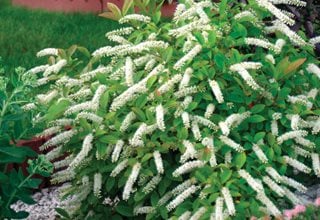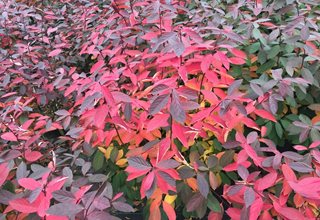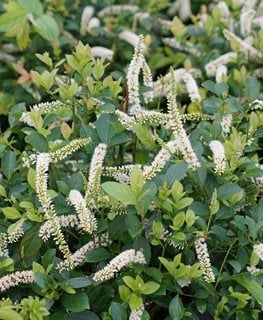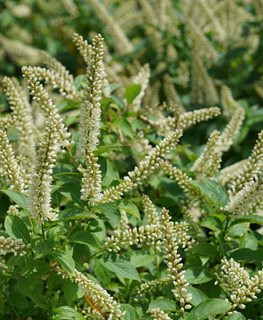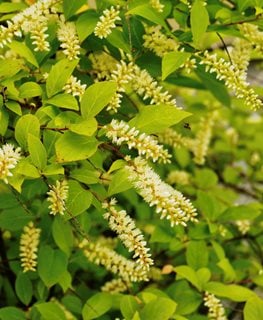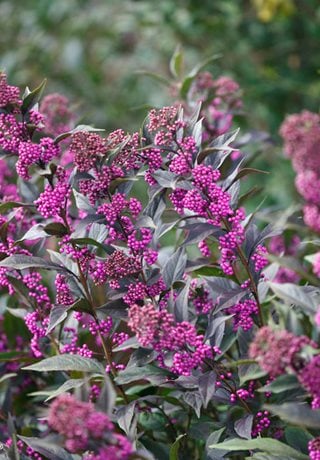A GUIDE TO GROWING ITEA (VIRGINIA SWEETSPIRE)
Combining beauty and brawn, sweetspire is the perfect flowering shrub for tough conditionsIn an age of climate change and wildly unpredictable weather, we all need more plants in our gardens that can roll with the punches and still look gorgeous, come what may. One such plant is Virginia sweetspire, a durable native shrub that grows well in either sun or shade and tolerates drought as well as flooding rains.
Itea shrubs thrive in almost any soil type, including clay, and are hardy in all but the coldest climates. Pests? Not a problem. Care requirements? Minimal. And if all that isn’t impressive enough, Virginia sweetspire is also modest in size and offers multiple seasons of interest, starting with a profusion of bottlebrush-like flower clusters in May and ending with spectacular fall foliage that remains colorful well into winter. Plus, it's deer resistant and attracts bees and butterflies.
On this page: Basics | Planting | Care | Pictures | Landscaping Tips
ITEA BASICS
Botanical name:
Itea virginica
Common names:
Virginia sweetspire, sweetspire, Virginia willow
Plant type:
Deciduous shrub
Zones:
5-9
Exposure:
Full sun to full shade
Mature size:
3 to 5 feet tall with an equal to slightly wider spread
Growth habit:
Rounded, with gracefully arching branches. Spreads slowly by suckers to eventually form an open thicket.
Growth rate:
Medium to fast
Bloom time:
May and June, with flowers lasting 4 to 6 weeks
Flowers:
Lightly fragrant, star-shaped white flowers bloom in clusters 3 to 6 inches long.
Foliage:
Glossy, elliptical dark-green leaves turn brilliant shades of orange, red, gold, burgundy, or reddish-purple in fall, depending on the cultivar. In areas with mild winters, the leaves often persist into December and beyond.
Related non-native species:
- Japanese sweetspire (Itea japonica) is a taller semi-evergreen shrub native to Japan.
- Hollyleaf sweetspire (Itea ilicifolia) is a broadleaf evergreen native to western China, with spiny, holly-like green leaves.
- Chinese sweetspire (Itea chinensis) is another evergreen species, but not as cold hardy (Zones 8-9).
PLANTING ITEA
When to plant:
Plant almost any time of year, although spring and fall are typically the best times.
Where to plant:
In sun or shade. For the best blooms and fall color, grow plants where they will receive 4 to 6 hours of sunlight daily. A site with morning sun and afternoon shade is ideal.
How to plant:
Dig a hole twice as wide and at the same depth as the root ball and set your shrub in the hole so that the top of the root ball is at ground level. Backfill with the excavated soil and water thoroughly. To conserve soil moisture, apply a 2- to 3-inch layer of mulch around the planting area.
Spacing:
Varies depending on the size at maturity and the intended use. For mass plantings or solid hedges, space plants a distance equal to their mature width.
ITEA CARE & MAINTENANCE
Pruning:
Generally not required unless you want to maintain an attractive shape or remove dead or damaged branches. Like rhododendron shrubs, sweetspire develops flowers on old wood, so prune your plants in early summer shortly after flowering to prevent the removal of next year's flower buds.
Soil:
Adapts to almost any soil type and drainage situation, even boggy conditions. Prefers a slightly acidic humus-rich soil, but is also tolerant of poorer clay and neutral to slightly alkaline soils.
Fertilizer:
Fertilize in spring with a well-balanced granular fertilizer formulated for trees and shrubs. Additional feeding during the growing season is usually unnecessary.
Watering:
Because sweetspire typically inhabits wet soils along swamps and streambanks, it thrives in soil that’s kept evenly moist. However, it will adapt well to average moisture conditions and even tolerate short periods of drought after becoming established. Overwatering is rarely a problem.
Diseases and pests:
This is one of those rare garden plants that has no serious pest or disease problems, although chlorosis (yellowing of the leaves due to lack of chlorophyll) may occur if grown in highly alkaline soils.
Controlling spread:
Because sweetspire is a "suckering" shrub that spreads by pushing up new shoots from the root system of the mother plant, it has a tendency to colonize over time. Depending on how you plan to use the plant in your garden, you may want to keep suckering in check by cutting off any unwanted root shoots that pop up, or plant it in an area it can be allowed to spread.
ITEA VARIETIES
ITEA LANDSCAPING & DESIGN TIPS
Because of its compact size and adaptable nature, you can use sweetspire in a multitude of ways, both ornamentally and as a problem solver in those areas of the garden where nothing else will flourish. Here are some ideas:
- At the edge of a woodland garden or as an understory planting in shady spots where other shrubs may not thrive.
- In rain gardens or to fill in low spots in the garden with poor drainage.
- For erosion control and soil stabilization along ponds and waterways.
- As an addition to a pollinator garden, where the fragrant blooms will attract butterflies and other pollinating insects.
- As a low ornamental hedge or shrub border along walkways and garden beds.
- In mass plantings as a tall groundcover or on slopes prone to erosion.
RELATED:
Shrubs 101
20+ Rain Garden Plants
Best Flowering Shrubs
Flowers for a Bee-Friendly Garden
